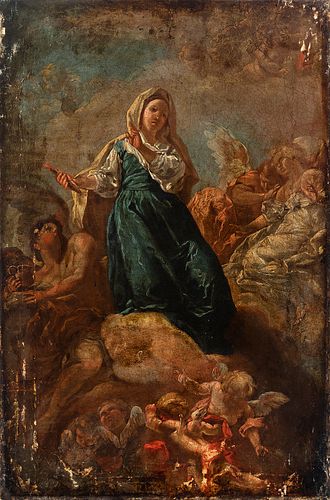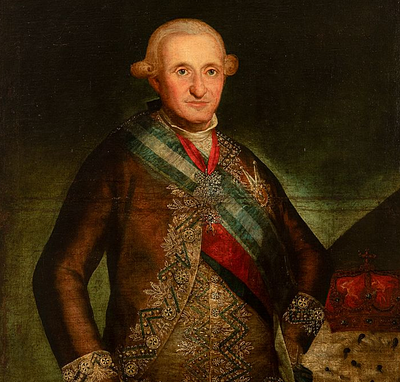Attributed to CORRADO GIAQUINTO (Italy, 1703 - 1765/66). "Santa Maria of the Head." Oil on canvas. Relined.
Lot 26
About Seller
Setdart Auction House
Carrer Aragó 346
Barcelona
Spain
Setdart Subastas was born in 2004 and is currently the first online art auction in Spain with solidity, prestige and reliability guaranteed by our more than 60,000 users. Setdart has a young, dynamic and enterprising team ready to successfully manage the purchase and sale of art works through custom...Read more
Estimate:
EUR€11,000 - EUR€12,000
$11,340.21 - $12,371.13
Absentee vs Live bid
Two ways to bid:
- Leave a max absentee bid and the platform will bid on your behalf up to your maximum bid during the live auction.
- Bid live during the auction and your bids will be submitted real-time to the auctioneer.
Bid Increments
| Price | Bid Increment |
|---|---|
| EUR€0 | EUR€10 |
| EUR€200 | EUR€25 |
| EUR€500 | EUR€50 |
| EUR€1,000 | EUR€100 |
| EUR€3,000 | EUR€200 |
| EUR€5,000 | EUR€500 |
| EUR€10,000 | EUR€1,000 |
| EUR€20,000 | EUR€2,000 |
| EUR€50,000 | EUR€5,000 |
About Auction
By Setdart Auction House
Sep 22, 2021
Set Reminder
2021-09-22 09:30:00
2021-09-22 09:30:00
America/New_York
Bidsquare
Bidsquare : 22nd September - ARAS JÁUREGUI Private Collection - Old Masters, 19th & 20th Century
https://www.bidsquare.com/auctions/setdart-auction-house/22nd-september---aras-j-uregui-private-collection---old-masters-19th-20th-century-7427
ARAS JÁUREGUI Private Collection - Old Masters, 19th & 20th Century Setdart Auction House sofia@setdart.com
ARAS JÁUREGUI Private Collection - Old Masters, 19th & 20th Century Setdart Auction House sofia@setdart.com
- Lot Description
Attributed to CORRADO GIAQUINTO (Italy, 1703 - 1765/66). "Santa Maria of the Head." Oil on canvas. Relined. It presents faults and repainting. Needs cleaning. Measurements: 52,5 x 34 cm. In this religious scene, a saint is placed in the centre of a break of glory, starred by numerous angels, who accompany and support the Saint. From her clothing and the attribute she holds in her hand, it is possible that this is a representation of Maria Toribia, a Spanish peasant girl, canonised by the Roman Catholic Church and known as Santa Maria de la Cabeza (Saint Mary of the Head). The date of birth of Saint María de la Cabeza is unknown, but it was sometime around the late 11th or early 12th century. The saint lived in Madrid, where she met and married Isidro, a simple peasant from Madrid (who, according to some sources, had fled there as a result of the Almoravid invasion). According to legend, one day their son fell into a deep well, leaving the parents with no recourse but prayer. Miraculously, the water level suddenly rose to ground level, and the baby was easily rescued unharmed. As a result, she and her husband committed themselves to sexual abstinence as a form of devotion. Due to its formal characteristics, the present work is attributed to Corrado Giaquinto, an Italian painter of the mid-18th century who is considered to be the leading representative of Rococo painting in Rome at the time. Due to his compositional mastery and masterful use of colour, the Italian artist became a point of reference for several generations of Spanish painters. The leading representative of Rococo painting in Rome in the first half of the 18th century, Giaquinto's work was a point of reference for several generations of Spanish painters. Appointed painter to Ferdinand VI in 1753 and until 1762, he was also artistic director of the Royal Tapestry Factory of Santa Barbara and director general of the San Fernando Royal Academy of Fine Arts. His language, which began with rococo and evolved in an increasingly classical direction, is characterised by a great sense of scenography and chromatic subtleties of extraordinary beauty. These two features are clearly evident here; the composition is totally theatrical, with the clarity of classicism combined with the elegant and graceful dynamism of rococo. The stage is organised in depth, playing with the position of the cumulus clouds and seeking a naturalistic representation of the space, with a sense of scenography inherited from the Baroque period. Giaquinto's is a classically influenced rococo, and his works will increasingly denote a more solid classicism: compositions of greater spatial clarity, as we see here, populated by solemn figures with lively gestures.
- Shipping Info
-
In-house shipping available. Please inquire at admin@setdart.com.
-
- Buyer's Premium



 EUR
EUR CAD
CAD AUD
AUD GBP
GBP MXN
MXN HKD
HKD CNY
CNY MYR
MYR SEK
SEK SGD
SGD CHF
CHF THB
THB

















